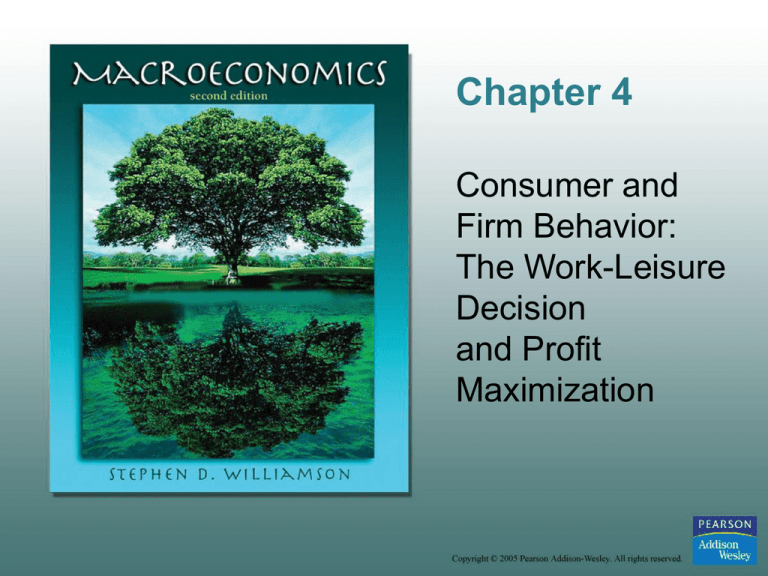
Chapter 4
Consumer and
Firm Behavior:
The Work-Leisure
Decision
and Profit
Maximization
The Representative Consumer
• Preferences
– Goods: The Consumption Good and
Leisure
– The Utility Function
U (C , l )
• More Preferred to Less
• Preference for Diversity
• Consumption and leisure are normal goods
Copyright © 2005 Pearson Addison-Wesley. All rights reserved.
4-2
– Indifference Curves
• Downward Sloping (more preferred to less)
• Convex to the Origin (preference for diversity)
– Marginal Rate of Substitution (MRS)
• Slope of the Indifference Curve
• Rate at which consumer is willing to substitute
leisure for consumption goods
Copyright © 2005 Pearson Addison-Wesley. All rights reserved.
4-3
Figure 4.1 Indifference Curves
Copyright © 2005 Pearson Addison-Wesley. All rights reserved.
4-4
Figure 4.2 Properties of Indifference
Curves
Copyright © 2005 Pearson Addison-Wesley. All rights reserved.
4-5
• Budget Constraint
– Price-taking Behavior
– The Time Constraint
lN
s
h
– Real Disposable Income: after tax
– A Graphical Representation
C wN T w(h l ) T
s
Copyright © 2005 Pearson Addison-Wesley. All rights reserved.
4-6
Figure 4.3 Representative
Consumer's Budget Constraint (T >
)
Copyright © 2005 Pearson Addison-Wesley. All rights reserved.
4-7
Figure 4.4 Representative
Consumer's Budget Constraint (T <
)
Copyright © 2005 Pearson Addison-Wesley. All rights reserved.
4-8
• Optimization
– Rational Behavior: can make informed
optimization decision
max U (C , l )
s.t.C w(h l ) T
– Optimization Condition: MRS Relative Price
MRSl ,c
U / l
w
U / C
– A Graphical Representation
Copyright © 2005 Pearson Addison-Wesley. All rights reserved.
4-9
Figure 4.5 Consumer Optimization
Copyright © 2005 Pearson Addison-Wesley. All rights reserved.
4-10
Figure 4.6 The Representative
Consumer Chooses Not to Work
Copyright © 2005 Pearson Addison-Wesley. All rights reserved.
4-11
• Comparative Statics Experiments
– Changes in Dividends () and Taxes (T):
Pure Income Effect, relative price (w) no
change both c and l
– Changes in the Real Wage (w): Income
and Substitution Effects c , l or
Copyright © 2005 Pearson Addison-Wesley. All rights reserved.
4-12
Figure 4.7 An Increase – T for the
Consumer
Copyright © 2005 Pearson Addison-Wesley. All rights reserved.
4-13
Figure 4.8 Increase in the Real Wage
Rate—Income and Substitution Effects
Copyright © 2005 Pearson Addison-Wesley. All rights reserved.
4-14
•Labor Supply Curve: N (w) h l (w)
s
–Substitution Effect > Income Effect
upward-sloping labor supply curve
–Substitution Effect < Income Effect
downward-sloping labor supply curve
•Question: What does L Supply
Curve look like in the data?
Copyright © 2005 Pearson Addison-Wesley. All rights reserved.
4-15
Figure 4.9 Labor Supply Curve
N s (w) h l (w)
Copyright © 2005 Pearson Addison-Wesley. All rights reserved.
4-16
Figure 4.10 Effect of an Increase in
Dividend Income or a Decrease in
Taxes
Copyright © 2005 Pearson Addison-Wesley. All rights reserved.
4-17
Figure 4.12 Real Wage in the United
States, 1980–2003
Copyright © 2005 Pearson Addison-Wesley. All rights reserved.
4-18
Figure 4.13 Average Weekly Hours
in the United States, 1980–2003
Copyright © 2005 Pearson Addison-Wesley. All rights reserved.
4-19
• An Example: consumption and leisure
are perfect complements (with Leontief
preference)
min(C , al )
s.t.C w(h l ) T
Copyright © 2005 Pearson Addison-Wesley. All rights reserved.
4-20
Figure 4.11 Perfect Complements
b/w C and L
Copyright © 2005 Pearson Addison-Wesley. All rights reserved.
4-21
•Non-wage disposable income -T
both c and l
•Wage w both c and l (no
substitution effect)
Copyright © 2005 Pearson Addison-Wesley. All rights reserved.
4-22
The Representative Firm
• The Production Function
Y zF ( K , N )
d
• Properties of Production Function
– Constant Returns to Scale
Y zF ( K , N ) zF ( K , N )
d
Copyright © 2005 Pearson Addison-Wesley. All rights reserved.
d
4-23
d
K
,
N
Y
– Monotonicity:
Y / K MPK 0
Y / N MPN 0
– Declining MPK
MPK / K 0
– Declining MPN
MPN / N 0
Copyright © 2005 Pearson Addison-Wesley. All rights reserved.
4-24
– Changes in Capital and MPN
MPN / K 0
– Total Factor Productivity
z Y , MPN , MPK
Copyright © 2005 Pearson Addison-Wesley. All rights reserved.
4-25
Figure 4.14 Production Function, Fixing
the Quantity of Capital and Varying the
Quantity of Labor
Copyright © 2005 Pearson Addison-Wesley. All rights reserved.
4-26
Figure 4.15 Production Function, Fixing
the Quantity of Labor and Varying the
Quantity of Capital
Copyright © 2005 Pearson Addison-Wesley. All rights reserved.
4-27
Figure 4.16 Marginal Product of Labor
Schedule for the Representative Firm
Copyright © 2005 Pearson Addison-Wesley. All rights reserved.
4-28
Figure 4.17 Adding Capital Increases the
Marginal Product of Labor
Copyright © 2005 Pearson Addison-Wesley. All rights reserved.
4-29
Figure 4.18 Total Factor Productivity
Increases
Copyright © 2005 Pearson Addison-Wesley. All rights reserved.
4-30
Figure 4.19 Effect of an Increase in Total
Factor Productivity on the Marginal
Product of Labor
Copyright © 2005 Pearson Addison-Wesley. All rights reserved.
4-31
TFP and Aggregate Production
Function
• Cobb-Douglas production function
d 1
Y zK ( N )
• Check it satisfies all the properties
• Capital income share =
• The measure of the TFP: Solow
Residual
Y
z
Copyright © 2005 Pearson Addison-Wesley. All rights reserved.
K
0.36
N
0.64
4-32
Figure 4.20 The Solow Residual for
the United States
Copyright © 2005 Pearson Addison-Wesley. All rights reserved.
4-33
Profit Maximization
• Profits = Total Revenue Total Variable
Costs
zF ( K , N ) wN
d
d
• Firm maximizes profits by setting
optimization condition
MPN w
• This condition defines the labor demand
curve
Copyright © 2005 Pearson Addison-Wesley. All rights reserved.
4-34
Figure 4.21 Revenue, Variable
Costs, and Profit Maximization
Copyright © 2005 Pearson Addison-Wesley. All rights reserved.
4-35
Figure 4.22 The Marginal Product of
Labor Curve Is the Labor Demand Curve
of the Profit-Maximizing Firm
Copyright © 2005 Pearson Addison-Wesley. All rights reserved.
4-36








